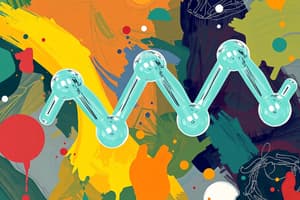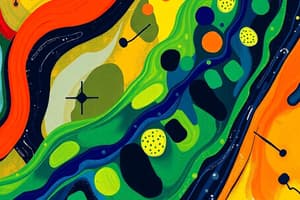Podcast
Questions and Answers
Which of the following is the primary function of the glucose-alanine cycle?
Which of the following is the primary function of the glucose-alanine cycle?
- To convert urea into amino nitrogen in the liver.
- To replenish the energy supply of the liver.
- To allow non-hepatic tissues to deliver the amino portion of catabolized amino acids to the liver for excretion as urea. (correct)
- To generate pyruvate in muscle and other peripheral tissues.
Which molecule is transaminated to alanine in the glucose-alanine cycle?
Which molecule is transaminated to alanine in the glucose-alanine cycle?
- Glucose
- Amino nitrogen
- Urea
- Pyruvate (correct)
What is the donor of the amino group in the transamination reaction in the glucose-alanine cycle?
What is the donor of the amino group in the transamination reaction in the glucose-alanine cycle?
- An α-amino acid (correct)
- Urea
- Pyruvate
- Glucose
What is the indirect mechanism for muscle to eliminate nitrogen in the glucose-alanine cycle?
What is the indirect mechanism for muscle to eliminate nitrogen in the glucose-alanine cycle?
What is the fate of the amino nitrogen in the glucose-alanine cycle?
What is the fate of the amino nitrogen in the glucose-alanine cycle?
What is the α-keto acid generated in the transamination reaction in the glucose-alanine cycle?
What is the α-keto acid generated in the transamination reaction in the glucose-alanine cycle?
What is the significance of the glucose-alanine cycle in energy metabolism?
What is the significance of the glucose-alanine cycle in energy metabolism?
Which amino acid is used as a donor of the amino group in the transamination reaction that generates alanine?
Which amino acid is used as a donor of the amino group in the transamination reaction that generates alanine?
What is the major function of the glucose-alanine cycle?
What is the major function of the glucose-alanine cycle?
What is the name of the cycle that describes the conversion of pyruvate to alanine and back to pyruvate in the liver?
What is the name of the cycle that describes the conversion of pyruvate to alanine and back to pyruvate in the liver?
What is the fate of the amino nitrogen in the urea cycle?
What is the fate of the amino nitrogen in the urea cycle?
What is the role of the transamination reaction in the glucose-alanine cycle?
What is the role of the transamination reaction in the glucose-alanine cycle?
Which tissues are involved in the glucose-alanine cycle?
Which tissues are involved in the glucose-alanine cycle?
What is the end product of the glucose-alanine cycle?
What is the end product of the glucose-alanine cycle?
Flashcards
Glucose-alanine cycle
Glucose-alanine cycle
The metabolic pathway that allows non-hepatic tissues like muscle to deliver the nitrogen portion of broken-down amino acids to the liver for excretion as urea. This process helps maintain blood glucose levels and provide fuel for tissues.
What molecule becomes alanine in the glucose-alanine cycle?
What molecule becomes alanine in the glucose-alanine cycle?
Pyruvate acts as the recipient of the amino group, transforming into alanine in the muscle tissues.
What's the donor of the amino group in the glucose-alanine cycle?
What's the donor of the amino group in the glucose-alanine cycle?
The glucose-alanine cycle involves the transfer of amino groups from α-amino acids to pyruvate, converting it to alanine.
How does muscle eliminate nitrogen indirectly in the glucose-alanine cycle?
How does muscle eliminate nitrogen indirectly in the glucose-alanine cycle?
Signup and view all the flashcards
What happens to the nitrogen in the glucose-alanine cycle?
What happens to the nitrogen in the glucose-alanine cycle?
Signup and view all the flashcards
What α-keto acid is produced in the glucose-alanine cycle?
What α-keto acid is produced in the glucose-alanine cycle?
Signup and view all the flashcards
Why is the glucose-alanine cycle important for energy metabolism?
Why is the glucose-alanine cycle important for energy metabolism?
Signup and view all the flashcards
Which amino acid is the main amino group donor in the glucose-alanine cycle?
Which amino acid is the main amino group donor in the glucose-alanine cycle?
Signup and view all the flashcards
What is the main function of the glucose-alanine cycle?
What is the main function of the glucose-alanine cycle?
Signup and view all the flashcards
What is the name of the cycle that describes the conversion of pyruvate to alanine and back to pyruvate?
What is the name of the cycle that describes the conversion of pyruvate to alanine and back to pyruvate?
Signup and view all the flashcards
What is the fate of nitrogen in the urea cycle?
What is the fate of nitrogen in the urea cycle?
Signup and view all the flashcards
What role does transamination play in the glucose-alanine cycle?
What role does transamination play in the glucose-alanine cycle?
Signup and view all the flashcards
Which tissues are involved in the glucose-alanine cycle?
Which tissues are involved in the glucose-alanine cycle?
Signup and view all the flashcards
What is the end product of the glucose-alanine cycle?
What is the end product of the glucose-alanine cycle?
Signup and view all the flashcards
Study Notes
Glucose-Alanine Cycle
- The primary function of the glucose-alanine cycle is to eliminate excess nitrogen in the form of alanine from muscles and convert it back to pyruvate in the liver.
- In the glucose-alanine cycle, pyruvate is transaminated to alanine.
- The donor of the amino group in the transamination reaction is glutamate.
- The indirect mechanism for muscle to eliminate nitrogen in the glucose-alanine cycle is by releasing alanine into the bloodstream, which is then transported to the liver.
- The fate of the amino nitrogen in the glucose-alanine cycle is that it is converted back to pyruvate in the liver and eventually used for gluconeogenesis.
- The α-keto acid generated in the transamination reaction is pyruvate.
- The significance of the glucose-alanine cycle in energy metabolism is that it allows muscles to conserve energy by eliminating excess nitrogen and converting it back to a usable energy source.
- Glutamate is the amino acid used as a donor of the amino group in the transamination reaction that generates alanine.
- The major function of the glucose-alanine cycle is to eliminate excess nitrogen from muscles and convert it back to a usable energy source in the liver.
- The process that describes the conversion of pyruvate to alanine and back to pyruvate in the liver is also known as the glucose-alanine cycle.
- The fate of the amino nitrogen in the urea cycle is that it is excreted in the form of urea.
- The role of the transamination reaction in the glucose-alanine cycle is to convert pyruvate to alanine and back to pyruvate.
- The tissues involved in the glucose-alanine cycle are muscles and liver.
- The end product of the glucose-alanine cycle is pyruvate, which can be used for gluconeogenesis.
Studying That Suits You
Use AI to generate personalized quizzes and flashcards to suit your learning preferences.



